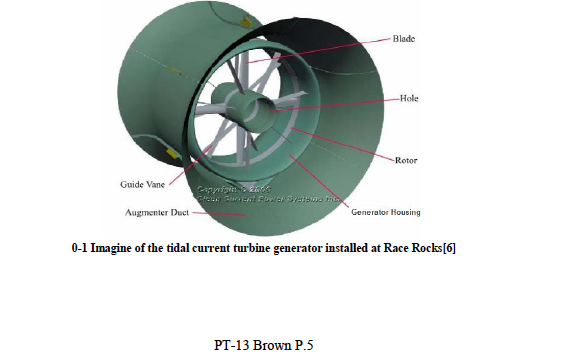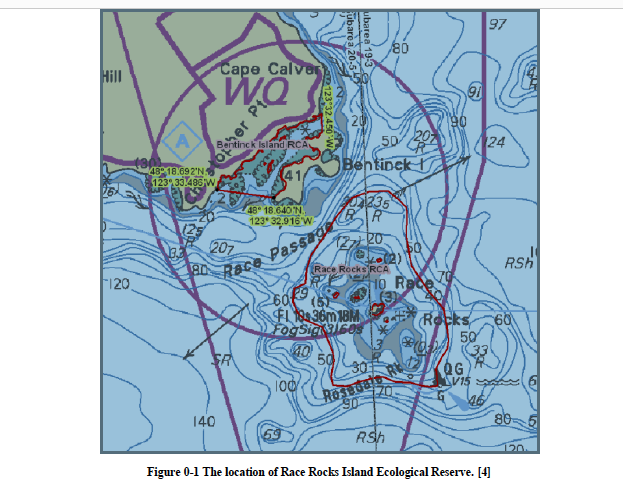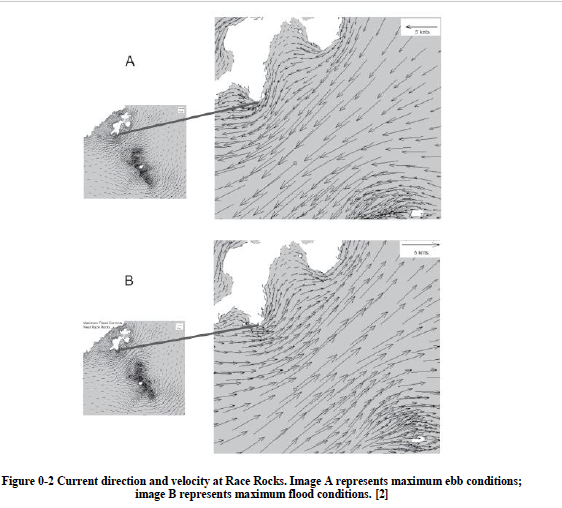PT-13: Coastal and Ocean Engineering ENGI.8751 Undergraduate Student Forum Faculty of Engineering and Applied Science, Memorial University, St. John’s, NL, Canada MARCH, 2013 Paper Code. (PT-13 – Brown)
PT-13 Brown P.1
The Tidal Current Turbine Energy Project in the Race Rocks Ecological Reserve
Erika Lee Brown
Memorial University of Newfoundland
St. John’s, Newfoundland, Canada
ELBrown@mun.ca
ABSTRACT
There is a predicted potential of 42 000MW stored in tidal energy off the coast of Canada which remains widely untapped by the energy industries.[1] Although there has been significant research and development done in the tidal energy sector, it has been a challenge to develop a cost efficient system which has a minimal environmental impact.
In 2006, the first tidal current generator to be built and installed in Canada was deployed north of the Middle Islands in the center of the Race Rocks Ecological Reserve off the coast of British Columbia. The current generator prototype was part of a six year joint research venture between Clean Current and the Race Rock project. The project aided to power Race Rocks using a combination of alternative energy technology to minimize the environmental impact of the facilities in the reserve while providing bases for testing of structural materials of the generator.
After numerous interruptions in power supply were experienced due to mechanical and electrical problems, the final phase of the project was completed in September 2011. The generator was retrieved from the seabed and transported to Vancouver for structural analysis.
The following paper will discuss the parameters of the study, as well as the challenges and problems encountered with the deployment, maintenance and retrieval of the tidal current system. A brief investigation of the outlook of tidal current generator systems as a means of power generation within Canada will also be completed.
1 INTRODUCTION
The Race Rocks located at 123° 31’ 85W latitude and 48° 17’ 95N longitude in the Juan de Fuca Strait off the coast of Vancouver Island, British Columbia is an ecologically diverse marine area. In 2001, Race Rocks was granted Ecological Reserve Status in British Columbia, Canada as Race Rocks Ecological Reserve. The reserve encompasses the main island of Great Race, as well as eight smaller islands, the water column and the seabed out to a depth of 36.6 m. [2] The designation of reserve status was created in the mid 1970s in the province in order to preserve a unique or representative ecosystem so that they may serve for research, education and a baseline for monitoring ecological change due to human encroachment. [3]
The islands within the Race Rocks Reserve do not have any permanent resides, however there are research and accommodation facilities present as the area is frequently inhabited on a temporary bases by various researchers and professors and students from Lester B. Pearson College. These facilities were electrically supplied by 15 and 25 kilowatt diesel generators.[5]
While the area is unique due to its ecological diversity, Race Rocks is also known for the  high currents present for which it was named. It is because of these high currents and the need to assist mariners with the navigation hazards that the lighthouse was establish on Great Rock in 1860. Although the lighthouse is located within the Ecological Reserve, the surrounding land is under the jurisdiction of the Canadian Coast Guard. [2] Due to maintenance costs, the Coast Guard switched powering of the lighthouse to solar energy. It was this transition to self-sufficient, low environmental impacting energy, which lead the wardens of the Race Rock Ecological Reserve to investigate similar alternative forms of energy.
high currents present for which it was named. It is because of these high currents and the need to assist mariners with the navigation hazards that the lighthouse was establish on Great Rock in 1860. Although the lighthouse is located within the Ecological Reserve, the surrounding land is under the jurisdiction of the Canadian Coast Guard. [2] Due to maintenance costs, the Coast Guard switched powering of the lighthouse to solar energy. It was this transition to self-sufficient, low environmental impacting energy, which lead the wardens of the Race Rock Ecological Reserve to investigate similar alternative forms of energy.
2 OPPORTUNITIES
Energy BC predicts that there is 42 000MW of stored tidal energy off the coasts of Canada, with approximately 7 000MW located in accessible regions along the east and west coasts which remain widely untapped. [1] The renewable energy industry is growing, with a strong research and development sector. In Canada, the majority of the research and implementation of tidal energy has been developed in barge type systems. This type of system has raised environmental concerns as they affect the natural tidal flow, as well as have notable negative impact on the marine environment.
An alternative method of extracting energy from the tides is through the use of tidal current turbines. These systems aim to utilize the natural tidal flow to turn the blades of a turbine, hence generating power. Initial research into harnessing tidal current energy revealed promising decreases in environmental impact to turbine sites and marine organisms. Prior to this case study, the design, construction, and deployment of a tidal current generator had not taken place in Canada. The strong research and tidal conditions indicative of the Race Rocks Reserve made it an ideal test site of the performance and marine impact of the new turbine design.
The bathometry and geometry of the Juan de Fuca Strait attest to the flow profile and characteristics that have been observed. The strait experiences a mixture of semi-diurnal and diurnal tides, shown in Figure 0-1, which causing upwelling of vital nutrients adding to the creation of the diverse ecosystem of the area.
As mentioned previously, Race Rocks has been historically identified as an area with high velocity tidal currents. Figure 0-2 below, from Fisheries and Oceans Canada, shows that the current can reach up to six knots through the Juan de Fuca Strait and are at their strongest at Race Rocks due to the narrowing of the channel.
As mentioned previously, Race Rocks has been historically identified as an area with high velocity tidal currents. Figure 0-2 below, from Fisheries and Oceans Canada, shows that the current can reach up to six knots through the Juan de Fuca Strait and are at their strongest at Race Rocks due to the narrowing of the channel.
Figure 0-2 Current direction and velocity at Race Rocks. Image A represents maximum ebb conditions; image B represents maximum flood conditions. [2]
3 PROJECT DESCRIPTION
The catalyst for the project was the desire of the reserve warden to have the island facilities operating in a sustainable manner using renewable energy. Prior to the commencement of the project, the island energy needs were provided by two diesel electric generators. Due to the future projected costs of the generators along with the negative effect on the marine environment as a result of the refueling and vibrations, the Integrated Energy Project was begun in Race Rocks in 1998.
1998. PT-13 Brown P.5
The desire of using sustainable energy and the unique tidal characteristics of Race Rocks made the site a very suitable location for harnessing tidal energy. Through the collaboration of Lester B. Pearson College with the Clean Current Energy Company, the Race Rocks Tidal Current Turbine Project was conceived. Pearson College benefited from the partnership by having an active educational and research opportunity and by receiving ongoing technical and monetary support from Clean Current throughout the project.
The objectives of the project partners were to:
provide sustainable energy to Race Rocks replacing the diesel generators,
contribute to the educational experience of Person College students
monitor the impact of the tidal turbine on the surrounding ecosystems,
test the seaworthiness of the turbine,
demonstrate the maintenance process for tidal current generators,
perfect the turbine structure, and
maximize turbine operation.
Clean Current Energy Company had developed a concept for the first tidal current turbine prototype to be designed and built in Canada. It was determined that the Race Rocks site would be an ideal location for testing the impact, functionality and structural integrity of the prototype.
3.1 Prototype
The tidal current turbine installed was a 1:5 scale prototype of the Clean Current Energy Company concept design. Due to the change in tidal current, the system was built to function bi-directionally. The turbine had a projected capacity of 65kW and a 3.5m blade diameter. [6]
3.2 Project Timeline
Throughout the first half of 2006, the site was prepared for the tidal current energy system on Race Rocks. The boathouse on Great Race was converted into an energy storage facility with the installation of batteries and various types of electronic equipment. After a turbine site had been confirmed, the site was dredged, drilled and piles were installed. Four cables to transmit the produced energy from the turbine to the batteries were laid along the seafloor from the turbine site to the boathouse. Concrete blocks were placed alongside the underwater cable to protect them from winter storm surges and a trench was dug to accommodate the cables on land. [7] On September 27, 2006, the turbine was installed in the middle islands in the center of the reserve with a 5m clearance from the water surface.
After disappointing performance results from the turbine, it was retrieved and underwent a refit. The turbine was upgraded to include stainless steel bearings, a new lubrication and electrical wire protection system, a new reinforced fiberglass augmenter duct, and reinforced struts. Along with these new additions, the turbine blade configuration was also modified.[8] Clean Current redeployed the revamped system October 17, 2008.
The portion of the trial to be performed at Race Rocks came to an end on September 17, 2011. The turbine was removed from the sea floor by Clean Current Staff and returned to Vancouver to undergo structural analyses.
4 PROJECT CHALLENGES
Throughout the life of the project, there were a number of challengers which the partners had to overcome.
Installation of the turbine proved to be a challenge due to the high current velocities in the region. It was necessary to time the installation so that it could take place during slack tide and ensure that the majority of the installation took place before the tide turned. [8]
The first operational problem encountered in the project was an unexpectedly rapid deterioration of the turbine bearings. This caused the system to be raised in April 2007 for them to be changed out.
Throughout the life of the Race Rocks tidal project, there were a number of interruptions in energy production and transmission to the island. Problems were noted with the fiber optic cable manufacturing which lead to electrical leakage. [8]
Although the estimated generator output was 65kW, the average every production was only 12.5 kW.[9] This led to the turbine being refit and redeployed in 2008.
5 FUTURE WORK
The involvement of Race Rock Ecological Reserve, and hence Lester B. Pearson College, ended when the turbine was extracted in 2011. At that point, the infrastructural and material component of the project was continued solely by Clean Current Energy Company.
The results of the structural analysis of the turbine infrastructure due to prolonged exposure to the ocean have yet to be released. Once a better understanding of the effects ocean environment can have on the materials used for the tidal current turbine is obtained, the design prototype will be adjusted to better suit the harsh environments for which tidal current extraction can be maximized.
It is the hope that the results of this project will enable other projects of its kind to be initiated along the Canadian coasts. The end goal is for the prototype to be brought to the final design phase, allowing for commercial tide current turbines to be installed and producing significant energy to the Canadian public.
6 CONCLUSION
The installation of Canada’s first tidal current turbine generator prototype designed by Clean Current Energy in the Race Rocks Ecological Reserve was a milestone in the Canadian renewable energy industry. The tidal current profile and marine ecological information within Race Rocks made it an ideal location to not only test the structural integrity of the turbine prototype but also its environmental impact on marine life.
Although the power supplied by the tidal current turbines to Great Race Island was inconsistent throughout the life of the project, it was a valuable asset to the Race Rock Ecological Reserve’s sustainable energy program. The energy provided by the generator was able to supply a base storage of electricity to the solar power batteries now in use on the island, therefore ensuring that the island be non-consumptive in its energy usage.
Not only did the program provide a foundation for the energy objectives of Race Rocks, but the data obtained from the turbine prototype will enable Clean Current to upgrade their design to better meet the industry needs. While the results of the structural analysis are still unknown, they will greatly contribute to the further research and development of the tidal energy industry.
|
REFERENCES [1] |
E. BC, “Tidal,” Tidal, 2012. [Online]. Available: http://www.energybc.ca/profiles/tidal.html. [Accessed 19 January 2013]. |
||||||||||||||
|
[2] |
C. Wright and J. Pringle, “Race Rocks Pilot Marine Protected Area: An Ecological Overview,” Fisheries and Oceans Canada, Sidney, British Columbia, 2001
|



